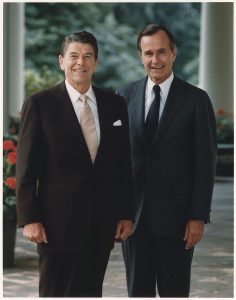George H.W. Bush was a ‘war hero’ nobody knew until a Baltimore P.R. man helped tell the story
BALTIMORE — The first time George H.W. Bush got serious about running for president, he ran into problems of perception. Newsweek Magazine, which people still took seriously back then, ran a cover story headlined, “The Wimp Factor.”
George Bush, a wimp? The guy was a war hero, only nobody knew it – until Bush hooked up with a public relations consultant from Baltimore named Robert Goodman, who turned Bush’s image around in precisely 30 seconds.
Bush didn’t grab the presidency that year, 1980, but the 30 seconds told a remarkable piece of his history and helped him land a spot as Ronald Reagan’s vice president. And, eight years later, it helped win Bush the presidency.
The 30 seconds came from old war footage, which is recalled now as we bid farewell to Bush, who died over the weekend, at the close of 94 years. You might say more than 70 of those years were lived on borrowed time.
“The guy was a war hero, only nobody knew it,” Bob Goodman was saying one day, nearly 40 years ago, as he sat in his suburban northwest Baltimore office. Goodman was a consultant who worked for people on both sides of the political aisle – from Adlai Stevenson to Spiro Agnew – as long as he liked the guy.
“Our job,” he said that day, “was to find a way to let people know who George Bush really was.”

Bush was 18 when he signed up for World War II. He was the U.S. Navy’s youngest fighter pilot, and was shot down in the Pacific in the early going of the conflict. In the midst of the 1980 presidential primaries, when Newsweek was questioning Bush’s “wimp factor,” it was Goodman who rummaged through old military film footage, looking for Bush’s rescue, and somehow found it.
And that footage became a 30-second commercial that finally told voters about Bush’s background.
There he was, in the film, getting fished out of the overpowering Pacific. There he was, exhausted and staggering across the flight deck of an aircraft carrier, drenched but still going – and on his way to roughly 150 combat missions.
He came from a different breed of presidential contenders, didn’t he? Never mind party affiliation, never mind political bent, we’re talking here about background. Before he dared reach for the presidency, Bush learned the trade.
He’d served in the military, in Congress, as ambassador to China, as CIA director, as vice president. He lived his life guided by honor and duty and patriotism. We have a man in the White House today, Donald Trump, who got there strictly on bluff and bullying. He’s lived his life in pursuit of the dollar. He is all bluster.

Bush was the most civil of men, and the most modest. During that 1980 campaign, he came to Baltimore and spoke before a small crowd at a restaurant in the city’s Little Italy.
When I got there that day, nobody else had arrived yet. We chatted for several minutes, and Bush was charming and self-effacing. He seemed more like a nice fellow from down the street than a big shot running for the most important job in the world.
“What are you doing here?” I asked. I meant Little Italy, since it was a Democratic stronghold back then, whose residents had included two Baltimore mayors and another politician of national stature.
“I’m here,” he laughed, “because they tell me this restaurant’s the only Republican place in this neighborhood. Nobody else would have me.”
As he laughed, he nodded directly across a narrow street, toward a household where the D’Alesandro family lived for generations. They included Thomas D’Alesandro Jr, the three-time mayor of Baltimore, and his son, the one-term mayor, Tommy D’Aleandro III.
Also, there was a girl in the family, who grew up in that household across the street, and she got married, and eventually she went into politics. Her name is Nancy Pelosi.
Sometimes, America feels like a small town.

Michael Olesker, columnist for the News American, Baltimore Sun, and Baltimore Examiner has spent a quarter of a century writing about the city he loves.He is the author of several books, including Michael Olesker’s Baltimore: If You Live Here, You’re Home, Journeys to the Heart of Baltimore, and The Colts’ Baltimore: A City and Its Love Affair in the 1950s, all published by Johns Hopkins Press.
